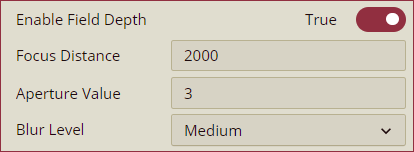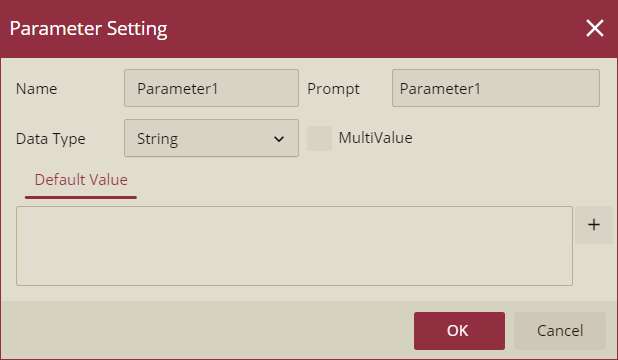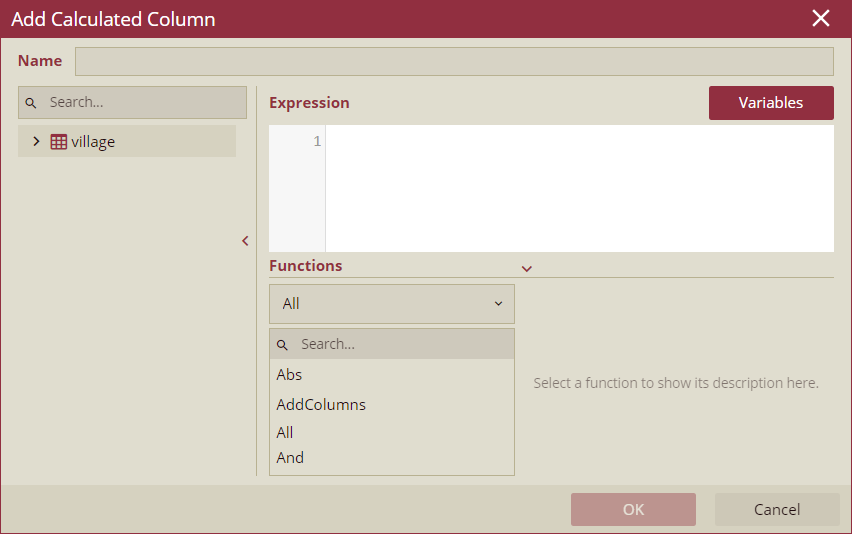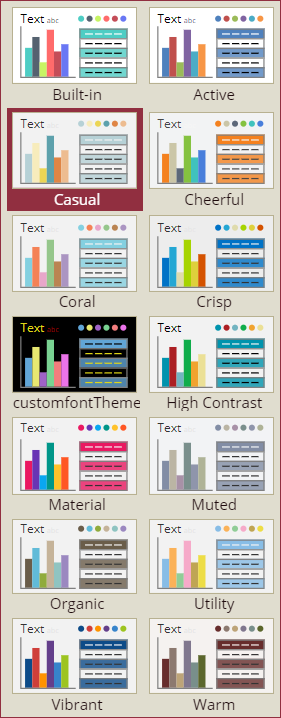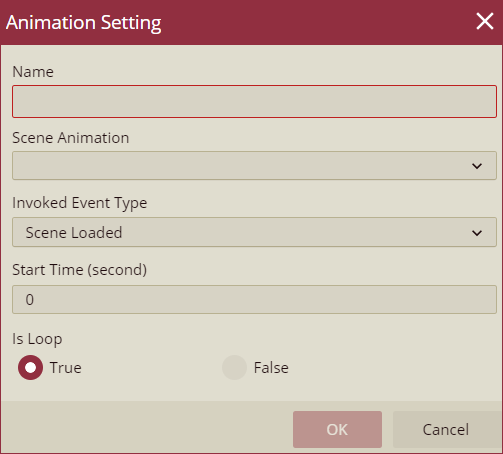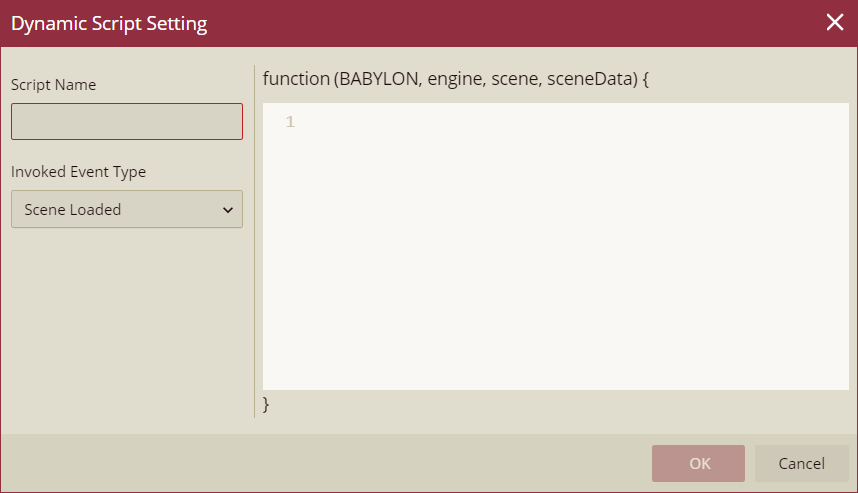- Getting Started
- Administration Guide
- User Guide
- Developer Guide
Create 3D Scene
3D Scene is a visualization tool in Wyn Enterprise designed to represent three-dimensional data using 3D models and their associated data. Comprising three integral sections — 3D models, lights, and data layers — further elaborated in subsequent sections of this document, the 3D Scene in Wyn Enterprise facilitates the addition of data labels to models sourced from data repositories, enhancing the informational depth of your scene.
Utilizing babylon.js for the construction, loading, and display of the 3D Scene, Wyn Enterprise supports the integration of dynamic data scripts tailored to your specific requirements within the 3D environment. These scenes can be seamlessly embedded into your dashboards, offering an enhanced visualization of your data. See the 3D Scene help article, for detailed information on embedding 3D Scenes within your dashboard.
In this article you will find information on the following:
3D Scene Designer
The image below displays the elements of the 3D Scene Designer page, followed by a detailed explanation of these elements.
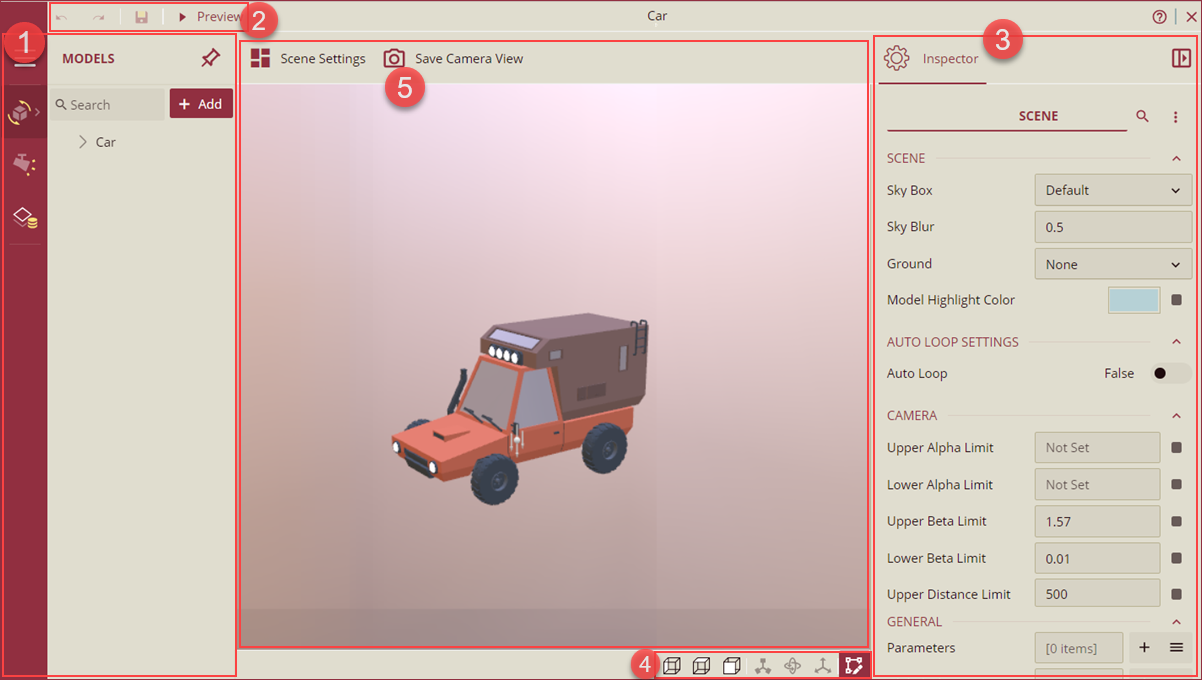
Scene Explorer: Displays the hierarchical tree of all the elements of the 3D Scene listed below. You can hide, delete, or focus each scene element from the Scene Explorer.
Models: Lists all the 3D models of the scene in a hierarchical model tree structure. 3D models are divided into two parts as described below.
Transform Node: Acts as a container to group multiple meshes together. Transform Node allows collective transformations such as moving, rotating, or scaling.
Mesh: Individual objects of 3D models that make up the scene. Each mesh can be transformed individually,
Lights: Includes options to add or remove lights. By default, light with intensity 1 is added to the 3D scene upon initialization. The available light options are explained below,
Directional Light: Directional lights are used as a distant source of light that hits all the objects in a 3D Scene from the same angle regardless of the object's position.
Point Light: Point Light sources are the light sources used to produce a uniform beam of light with the illumination scattered in all directions. Point Light sources are also known as omnidirectional lights.
Spot Light: Spot Light sources are generally used for artificial light sources such as flashlights, headlights, and searchlights. The moving spotlight will illuminate a small area of the scene only.
Hemispheric Light: Hemispheric Light sources are used to stimulate ambient environment light.
Data Layer: Data Layers display the data related to the model objects of the 3D Scene. You can also bind data to the data layers which include the following data roles,
Value: Represents the sum or count value associated with the data fields.
Mesh Name: Represents the name of the 3D object within the application.
Tooltip: Provides additional information on a data point, usually on mouse hover.
See the Manage Data Layers article for more information.
Command Bar: Provides quick access to essential functions like Undo, Redo, Save, Preview, and Exit.
Settings: Includes the Inspector Panel to manage the properties of scene objects and the Data Binding Panel to bind data to the scene.
Status Bar: Included options to change the view directions (Side View, Top View, and Primary View), mesh selection modes (Scaling, Position, and Rotation), and highlighting.
Canvas: The main area to render and interact with the 3D scene. It provides a visual representation of the scene and lets you engage with the 3D objects. The following two options are available on the Canvas area,
Scene Settings: Allows you to configure an entire scene. Click to access and modify specific settings in the Inspector Panel.
Save Camera View: Save the current camera perspective using this button. The most recently saved perspective will be used on the preview.
This article provides information on creating 3D Scenes in Wyn Enterprise.
Prepare 3D Model
When creating a 3D Scene, 3D models are required to display the entire scene and the associated data. Upload a model file in .GLB format using the Upload feature on the Resource Portal. See the Upload article for more information on uploading files in Wyn Enterprise.
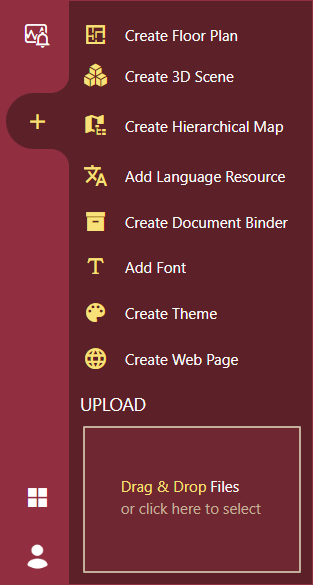
Uploaded 3D Models are listed on the 3D Models document list on the Resource Portal under the Document Types section.
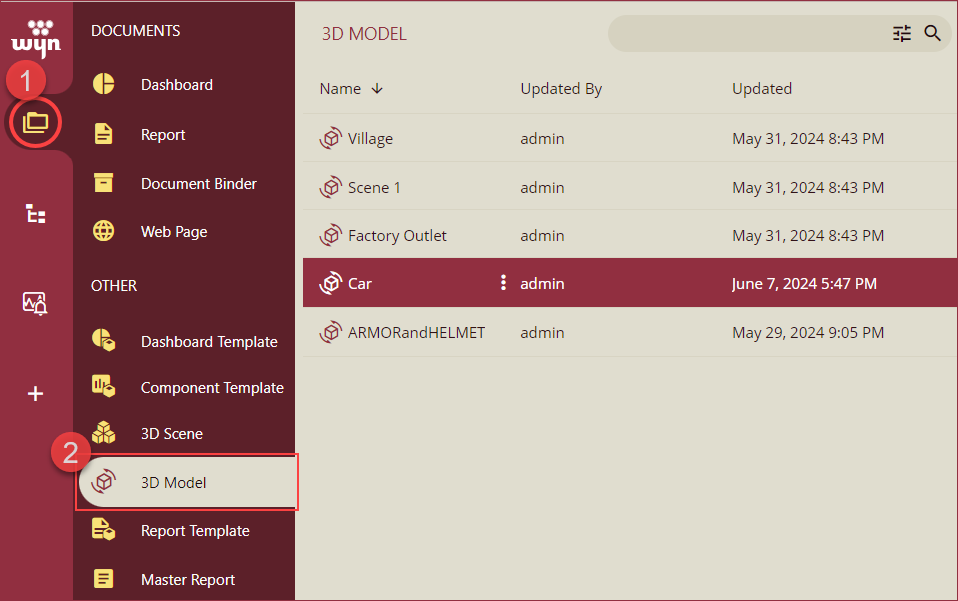
Create 3D Scene
To create a 3D Scene from the Resource Portal. Follow these steps,
Click the + (create) button.
Click Create 3D Scene to open the 3D Scene Designer.
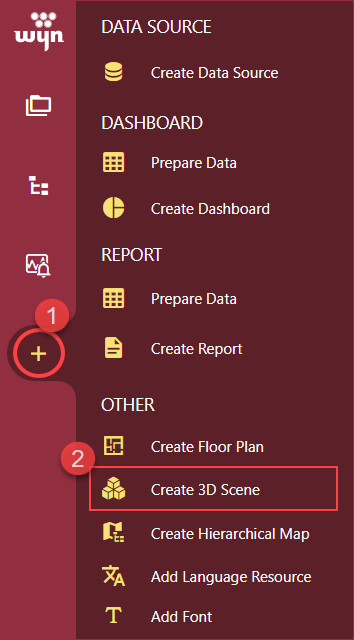
To add a 3D Model to the scene, click the + Add button in the Models section of the Scene Explorer. This will open the Model Manager.
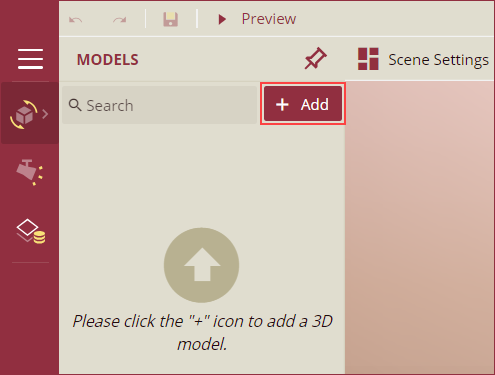
Select a 3D model prepared earlier, from the Shared tab of the Model Manager. Use the search bar to search for a model from the list. Click Ok to add the model to the 3D Scene.
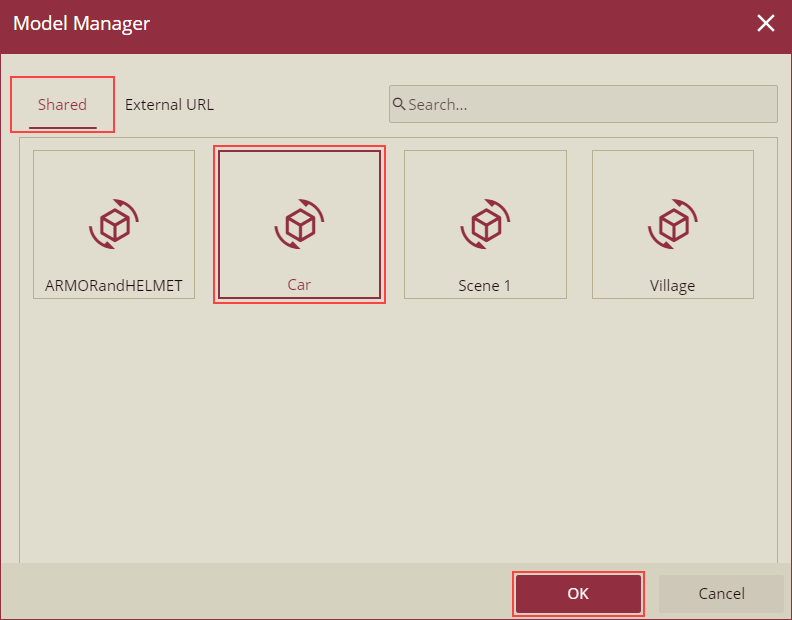
To use a 3D model available on an external URL, navigate to the External URL tab and enter the URL in the Model URL input box. Click Ok to add the model to the 3D Scene.
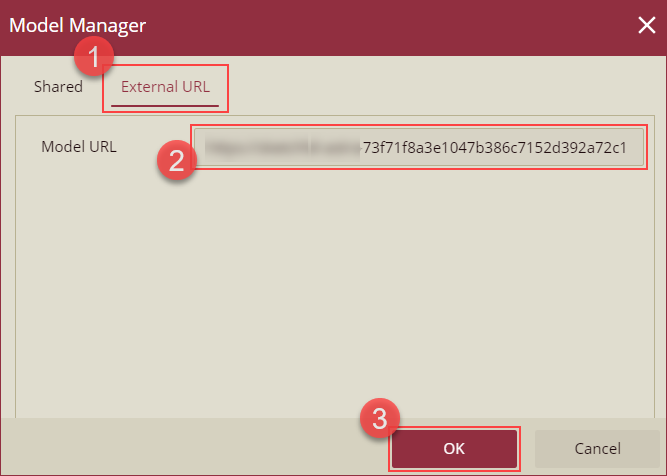
You can now use the Scene Explorer to add or manage Models, Lights, and Data Layers.
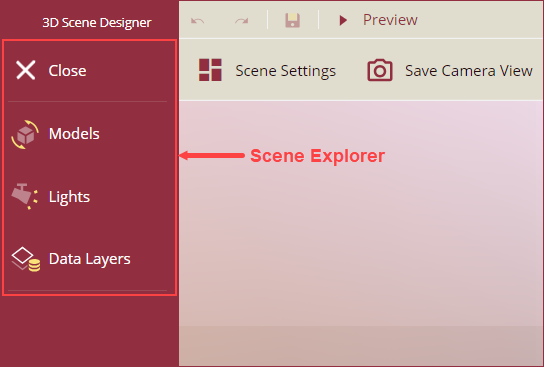
Use the Inspector Panel on the right side to manage the Scene Settings.
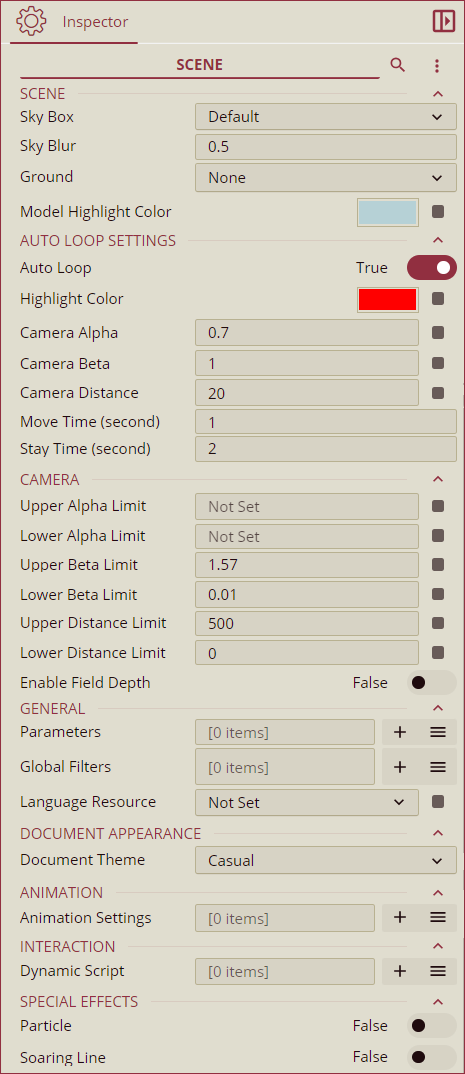
Use the Status bar to perform the following:

Change View Direction: Select an option to change the view direction to side, top, or primary view. All three views of the 3D model of a car are shown in the below image.

Modify Mesh: Select an option to adjust the scale, position, and rotation of the selected mesh. The image below shows all three modification options applied to a 3D model of a car.

Highlight: Click the highlight button to highlight the selected node on the canvas area. To remove the highlight, click the highlight button again.
Click the save button on the command bar, enter a name for the scene, select a Category (optional), and add a comment (optional) in the Save Scene popup. Click Ok to finish.
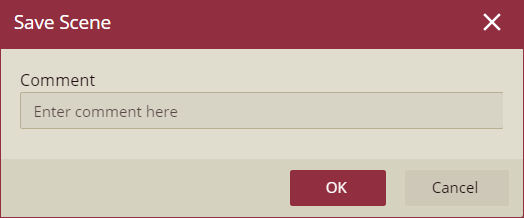
Scene Explorer
Add or manage the Models, Lights, and Data Layers of the 3D Scenes from the Scene Explorer. Click the scene menu button to expand the scene explorer and select one of the following:
Manage Models
Add 3D models to the scene using the + Add button.
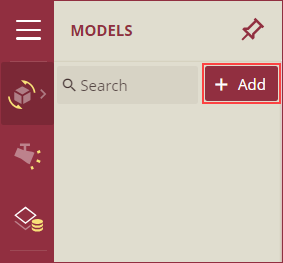
To hide, focus, or delete a transform node or mesh hover over it and click the corresponding buttons.

Select a transform node or mesh and manage the following properties using the Inspector Panel:
General
Property | Description |
|---|---|
Name | To change the name of the node or mesh, enter the name in the input box. |
Transformation
Property | Description |
|---|---|
Position | To change the horizontal position, vertical position, or depth of the node or mesh, enter the corresponding X, Y, and Z coordinate values in the input box with a space between each value, or click the expand button and enter the corresponding coordinates. |
Rotation | To change the orientation of the selected node or mesh, enter the X, Y, and Z axis coordinates to rotate it around the local X, Y, and Z axes. |
Scaling | To adjust the size of the node or mesh along the local X, Y, and Z axes, enter the X, Y, and Z coordinate values in the input box with a space between each value, or click the expand button and enter the corresponding coordinates. |
Auto Loop Camera Settings
Property | Description |
|---|---|
Preview Camera | Click this button to adjust the camera view to the specified Alpha, Beta, and Distance values. |
Apply Editor Camera | Click this button to set the Alpha, Beta, and Distance values as the current camera view. Clicking the Preview Camera button will now display this camera view. |
Alpha | Enter an angle (in radians) to change the horizontal angle of the camera around the node or mesh. |
Beta | Enter an angle (in radians) to change the vertical angle of the camera around the node or mesh. |
Distance | Enter a distance (in centimeters) to change the distance of the camera from the selected node or mesh. |
Manage Lights
To add lights to the scene, click the + Add button and select an option from the following: Directional Light, Point Light, Spot Light, or Hemispheric Light.
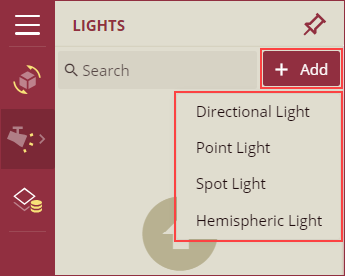
To hide or delete a light, hover over it and click the corresponding option.
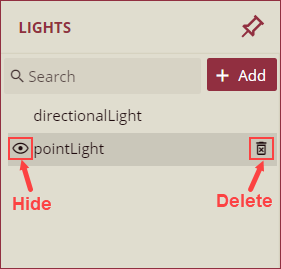
Select a light and manage the following settings using the Inspector Panel:
Property
Description
Name
Displays the name of the selected light.
Intensity
Displays the intensity of the light falling on the 3D object. The default value is 1.
Position
Displays the position of the light source with X, Y, and Z coordinates each separated by a space. This option is available for Point and Spot lights only.
Direction
Displays the vector direction of the light with X, Y, and Z coordinates each separated by a space. This option is available for Directional, Spot, and Hemispheric lights only.
Manage Data Layers
To add a data layer to the scene, click the + Add button. A data layer (modelDataAnnotation) will be added to the list.
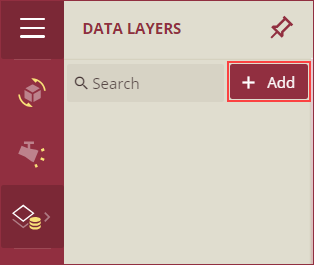
To disable or delete the data layer, hover over it and click the corresponding option. You can also add filters to the data layers using the filter icon on hover. See the Filter Data help article for more information.
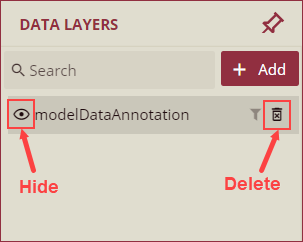
See the Manage Data Layers help article for information on binding data to layers and managing the data layer settings, including conditional formatting.
View and Manage 3D Scenes
Navigate to Document Types >> 3D Scene.
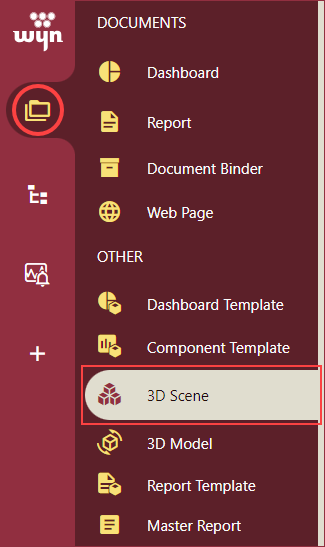
A list of all the available 3D scenes will appear on your screen.
Use sorting on column headers, the preview button to render the scene in the same window, and the View 3D Scene in New Window button to open the scene in a new window.
Use the context menu to perform the following: Edit 3D Scene, Duplicate, Copy URL, Categorize, Rename, Delete, and Download.
Use the search bar and action menu on the top right corner to search, edit category, delete, edit, duplicate, show checkbox, and enable tile view. Use the Info icon to view the document information and history.
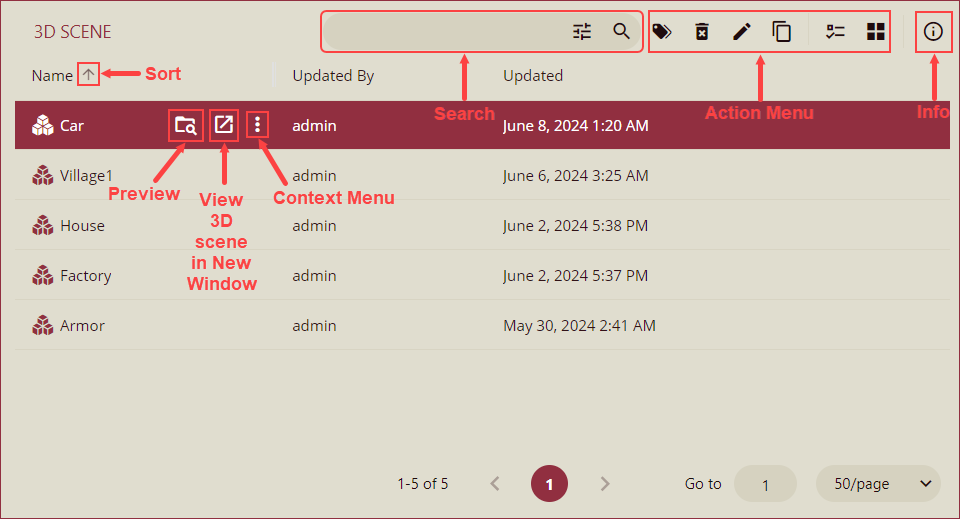
Example Scenario
In this example, we will create a 3D Scene of a Village with model houses, lights, and data layers from the Resource Portal.
Prepare a 3D model using the Upload feature and click the Create 3D Scene option to open the 3D Scene Designer.
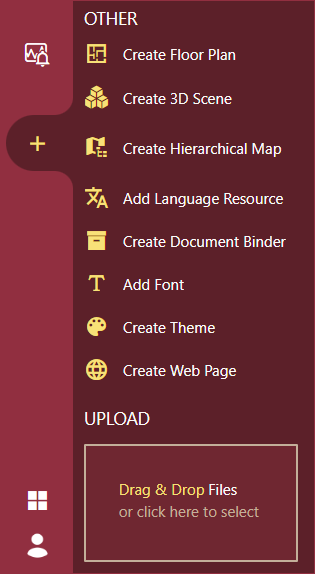
Click the + Add button under the Models section to open the Model Manager.
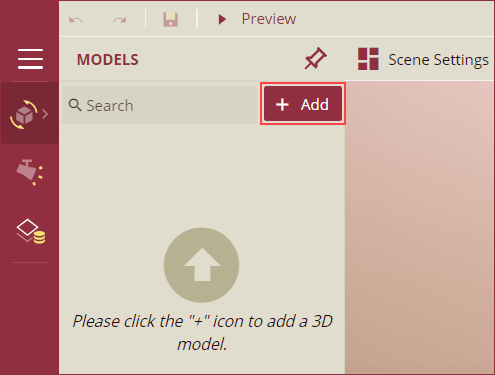
Select the Village model and click Ok to apply.
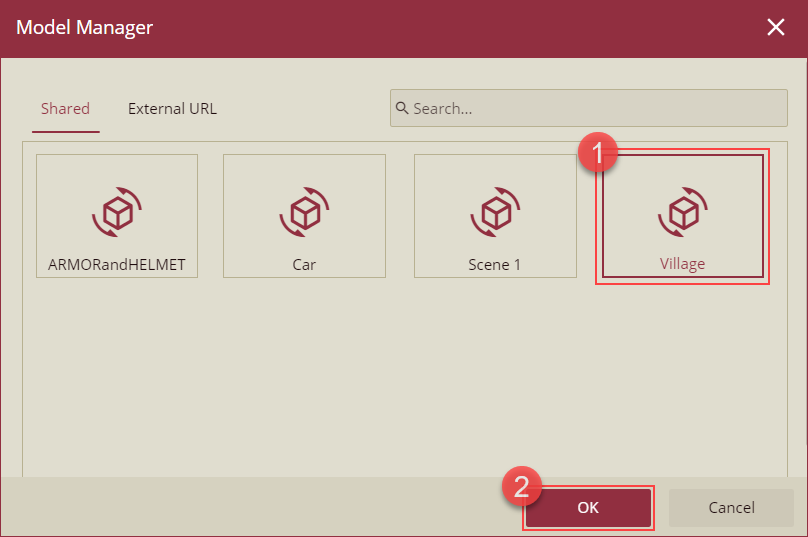
A village scene will be added to the Canvas area. From Scene Explorer, navigate to the Data Layers section and use the + Add button to add a data layer to the scene.
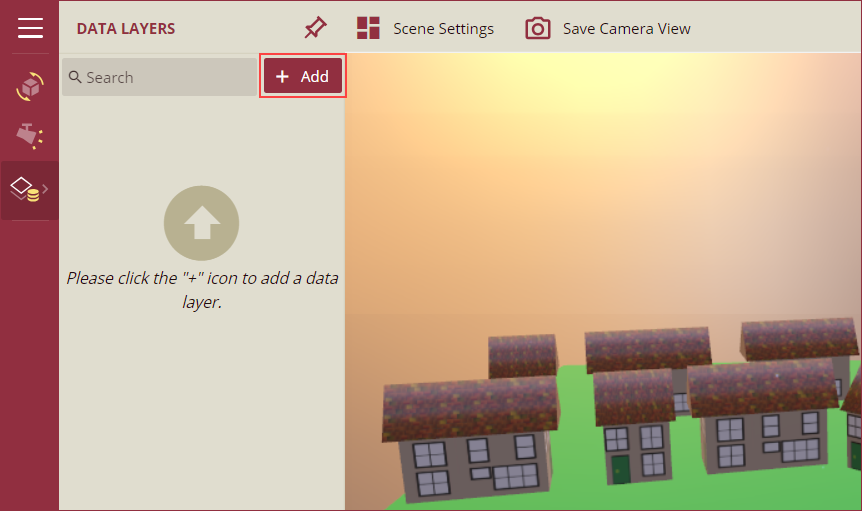
Select the Village dataset to bind data to the scene. Drag and drop the Model Content 1 data fields onto the Value data role and Model Name data field on the Mesh Name data role.
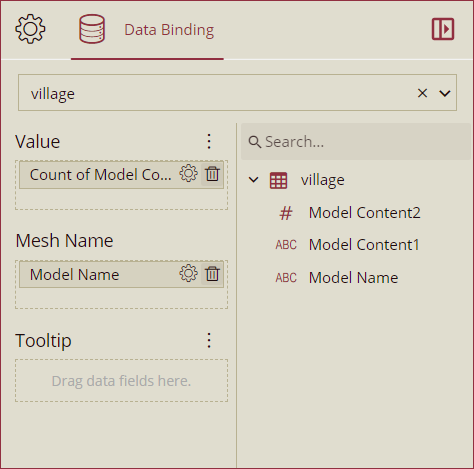
Click the Preview button to render the scene. Notice the data labels above houses 1, 4, and 7, these appear by binding the Village dataset fields to the scene.
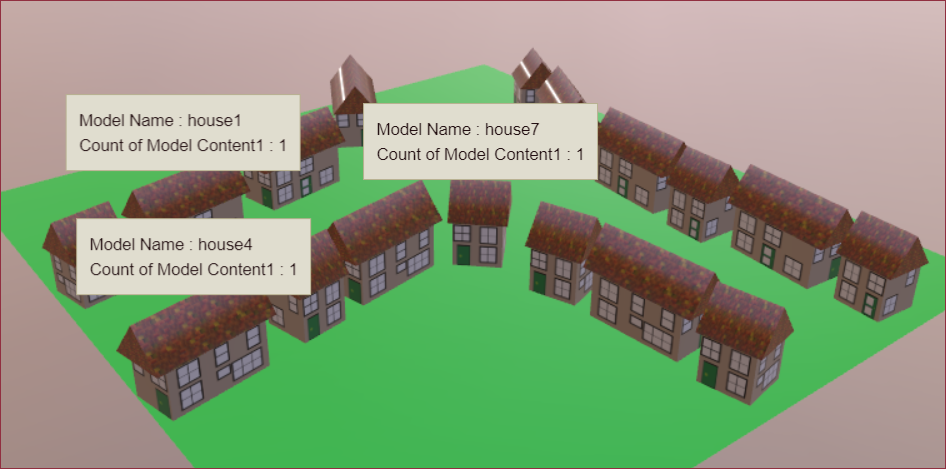
Click Save and enter a name for the scene. Click Ok to finish.
Scene Settings
SCENE
Property | Description |
|---|---|
Sky Box | To change the sky background of a 3D Scene, select an option from the dropdown. The available options are Default, Studio, Sky, Lilienstien, CapeHill, Wastelands Cloud Pure Sky, Custom URL, and None. By default, the Default option is selected.
|
Sky Blur | To control the blurriness of the sky background, add a value greater than 0 in the input box. 0.5 is the default value. |
Ground | Select an option from None or Grid Ground from the dropdown to set the ground background of the scene. By default, the None option is selected. - Grid Ground: Use the Grid Ground option to select a geometrical shape (Geometry1, Geometry 2, etc.) to display the grids in the ground. The Grid Ground dropdown appears on selecting the Grid Ground option from the Ground dropdown. - Background Color: Select a background color for the ground. - Line Color: Select the color of the grid line using this option. |
Model Highlight Color | Set a color to display for the highlighted model object. |
AUTO LOOP SETTINGS
Option | Description |
|---|---|
Auto Loop | To enable the auto loop of the camera set the Auto Loop option to True. By default, the value of Auto Loop is set as False. |
Highlight Color | Select the highlight color for node or mesh using this property. |
Camera Alpha | Set the angle ratio of the alpha camera using this property. |
Camera Beta | Set the angle ratio of the beta camera using this property. The value of the Camera Beta property can range from 0.01 to 1.57 (2/π). |
Camera Distance | Set the distance of the camera from the node or mesh using this property. |
Move Time (second) | Set a move time of the camera (in seconds) using this property. |
Stay Time (second) | Set the stay time of the camera using this property. |
CAMERA
Option | Description |
|---|---|
Upper Alpha Limit | Set the upper alpha limit of the camera using this property. |
Lower Alpha Limit | Set the lower alpha limit of the camera using this property. |
Upper Beta Limit | Set the upper beta limit of the camera using this property. The default value is 1.57. |
Lower Beta Limit | Set the lower beta limit of the camera using this property. The default value is 0.01. |
Upper Distance Limit | Set the upper distance limit of the camera using this property. The default value is 500. |
Lower Distance Limit | Set the lower distance limit of the camera using this property. The default value is 0. |
Enable Field Depth | To enable the camera depth of the field effect set the Enable Field Depth property to True. By default, the value is set to False. On enabling the field depth, the following options appear in the panel, Focus Distance: Set the focus distance of the camera using the Focus Distance option. Aperture Value: Set the aperture coefficient value of the camera using the Aperture Value option. Blur Level: Set the ambiguity level of the camera using the Blur Level dropdown. The available options are Low, Medium, and High.
|
GENERAL
Option | Description |
|---|---|
Parameters |
|
Global Filters | Add global filters to the scene using this property. |
Language Resource | To set a language resource select a resource from the dropdown. See the Language Resource help doc for more information. |
DOCUMENT APPEARANCE
Option | Description |
|---|---|
Document Theme | To change the theme of the 3D scene, select a theme from the Document Theme dropdown. The font color, font size, background, etc. will be affected when changing the document theme.
|
ANIMATION
Option | Description |
|---|---|
Animation Settings | To manage the execution settings of animations in the 3D scene, click the + button and configure the options on the Animation Setting popup as described below. You must upload a 3D model with animation to use this setting.
|
INTERACTION
Option | Description |
|---|---|
Dynamic Script | To embed a user code in the 3D scene click the + button and add the code in the Dynamic Script Setting popup. Wyn Enterprise uses Babylon.js to create dynamic scripts for a 3D scene. See the Customize Using JavaScript help doc for more information on dynamic scripts.
|
SPECIAL EFFECTS
Option | Description |
|---|---|
Particle | To enable particle effect in the 3D scene, set this option to True. By default, the value is set to False. |
Soaring Line | To enable the soaring line effect in the 3D scene, set this option to True. By default, the value is set to False. |
ANTI-ALIASING
Option | Description |
|---|---|
Enable MSAA | To disable MSAA (MicroSoft Active Accessibility) scheme, set the property to False. By default, the value is set to True. |





